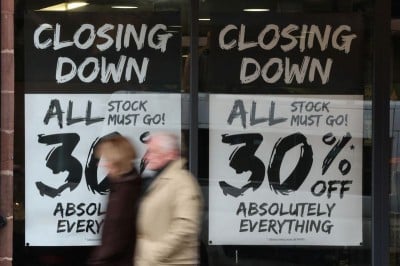England and Wales insolvencies hold near 14-year high
 © Reuters. FILE PHOTO: People walk past a shop with closing down signs in the window in Chester, Britain, November 17, 2022. REUTERS/Phil Noble/File Photo F +1.35% Add to/Remove from Watchlist Add to Watchlist Add Position
© Reuters. FILE PHOTO: People walk past a shop with closing down signs in the window in Chester, Britain, November 17, 2022. REUTERS/Phil Noble/File Photo F +1.35% Add to/Remove from Watchlist Add to Watchlist Add Position Position added successfully to:
+ Add another position Close
LONDON (Reuters) - The number of companies in England and Wales declared insolvent during the three months to the end of September remained close to levels seen after the 2008 financial crisis and was down only slightly from the previous quarter's 14-year high.
The Insolvency Service, a government agency, said the number of insolvencies fell 2% to 6,208 on a seasonally adjusted basis, but was 10% higher than in the same period a year earlier.
Many businesses and households have come under increased pressure from rising interest rates as well as and a jump in the cost of energy and other necessities such as food.
"The last two quarters saw the highest quarterly insolvency numbers since Q2 2009," the Insolvency Service said.
Most of the increase has been driven by a surge in creditors' voluntary liquidations - a form of insolvency where directors and creditors agree to wind up a struggling business, which is now the most common since records began in 1960.
There were also 735 compulsory liquidations, a similar level to before the COVID-19 pandemic but up by 46% on a year earlier. Until the end of March 2022, there were restrictions on courts winding up businesses affected by the pandemic.
The Bank of England raised interest rates 14 times between December 2021 and August 2023, lifting benchmark borrowing costs from 0.1% to 5.25%.
Most economists think the central bank will keep rates on hold on Thursday after its latest rate meeting, but do not expect a rate cut until the second half of next year.
"Escalating interest rates have added to the cost of servicing the already increased debt burden of some firms, made refinancing impossible or punitively expensive for others, and generally made access to funding difficult," said Mark Ford (NYSE:F), a restructuring partner at professional services firm Evelyn Partners.

